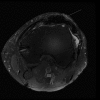Medial Quadriceps Tendon Femoral Ligament Reconstruction After Patellectomy: A Treatment for a Dislocating Quadriceps Tendon
- PMID: 30211345
- PMCID: PMC6132308
- DOI: 10.5435/JAAOSGlobal-D-17-00001
Medial Quadriceps Tendon Femoral Ligament Reconstruction After Patellectomy: A Treatment for a Dislocating Quadriceps Tendon
Abstract
The medial quadriceps tendon femoral ligament (MQTFL) reconstruction is an alternative to the patellar bony fixation of the medial patellofemoral ligament reconstruction for the treatment of lateral patellofemoral dislocation. We describe the first report of a unique application of this technique in a patient with a previous patellectomy to treat a dislocating quadriceps tendon. An active 59-year-old Caucasian man presented 25 years after patellectomy with a dislocating quadriceps tendon and significant dysfunction. Stabilization of the knee extensor mechanism with an MQTFL reconstruction and retensioning of the quadriceps complex by tibial tubercle distalization provided stability and improved function. Extensor tendon instability is a rare complication after patellectomy that can cause significant pain and dysfunction. Successful stabilization of the quadriceps mechanism through an MQTFL reconstruction can provide excellent patient satisfaction and functional results. This technique may have implications for patellofemoral instability surgeries and in cases of knee extensor dysfunction after total knee arthroplasty.
Conflict of interest statement
Dr. Hiemstra serves as a paid consultant to CONMED Linvatec and has received research or institutional support from CONMED Linvatec Sanofi Genzyme, LifeMark Health, and Smith & Nephew. Dr. Frizzell and Ms. Kerslake have no conflicts of interest to disclose.
Figures



Similar articles
-
Comparison of Patellofemoral Kinematics and Stability After Medial Patellofemoral Ligament and Medial Quadriceps Tendon-Femoral Ligament Reconstruction.Am J Sports Med. 2020 Jul;48(9):2252-2259. doi: 10.1177/0363546520930703. Epub 2020 Jun 18. Am J Sports Med. 2020. PMID: 32551965
-
Combined Reconstruction of the Medial Patellofemoral Ligament (MPFL) and Medial Quadriceps Tendon-Femoral Ligament (MQTFL) for Patellar Instability in Children and Adolescents: Surgical Technique and Outcomes.J Pediatr Orthop. 2019 Jan;39(1):e54-e61. doi: 10.1097/BPO.0000000000001259. J Pediatr Orthop. 2019. PMID: 30300273
-
Medial Quadriceps Tendon Femoral Ligament Reconstruction Technique and Surgical Anatomy.Arthrosc Tech. 2018 Dec 24;8(1):e57-e64. doi: 10.1016/j.eats.2018.09.002. eCollection 2019 Jan. Arthrosc Tech. 2018. PMID: 30899652 Free PMC article.
-
Medial quadriceps tendon-femoral ligament: surgical anatomy and reconstruction technique to prevent patella instability.Arthrosc Tech. 2013 Apr 12;2(2):e125-8. doi: 10.1016/j.eats.2013.01.002. Print 2013 May. Arthrosc Tech. 2013. PMID: 23875137 Free PMC article.
-
Patellofemoral complications following total knee arthroplasty.Instr Course Lect. 2001;50:403-7. Instr Course Lect. 2001. PMID: 11372340 Review.
Cited by
-
Chondromalacia patellae: current options and emerging cell therapies.Stem Cell Res Ther. 2021 Jul 18;12(1):412. doi: 10.1186/s13287-021-02478-4. Stem Cell Res Ther. 2021. PMID: 34275494 Free PMC article. Review.
References
-
- Hiemstra LA, Kerslake S, Loewen M, Lafave M: Effect of trochlear dysplasia on outcomes after isolated soft-tissue stabilization for patellar instability. Am J Sports Med 2016;44:1515–1523. - PubMed
-
- Schöttle PB, Schmeling A, Rosenstiel N, Weiler A: Radiographic landmarks for femoral tunnel placement in medial patellofemoral ligament reconstruction. Am J Sports Med 2007;35:801–804. - PubMed
-
- Einola S, Aho AJ, Kallio P: Patellectomy after fracture: Long-term follow-up results with special reference to functional disability. Acta Orthop Scand 1976;47:441–447. - PubMed
-
- Cavaignac E, Pailhé R, Reina N, Wargny M, Bellemans J, Chiron P: Total patellectomy in knees without prior arthroplasty: A systematic review. Knee Surg Sports Traumatol Arthrosc 2014;22:3083–3092. - PubMed
Publication types
LinkOut - more resources
Full Text Sources
Other Literature Sources

